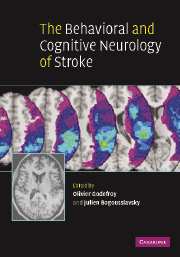Book contents
- Frontmatter
- Contents
- Contributors
- Preface
- 1 Evaluation of cognitive and behavioral disorders in the stroke unit
- Motor and gestural disorders
- Aphasia and arthric disorders
- Hemineglect, Anton–Babinski and right hemisphere syndromes
- Agnosia and Bálint's syndrome
- 14 Cortical blindness
- 15 Bálint's syndrome
- 16 Prosopagnosia
- 17 Object and color agnosia
- 18 Auditory disorders related to strokes
- Executive and memory disorders
- Behavioral and mood disorders
- Dementia and anatomical left/right syndromes
- Index
- References
17 - Object and color agnosia
Published online by Cambridge University Press: 10 October 2009
- Frontmatter
- Contents
- Contributors
- Preface
- 1 Evaluation of cognitive and behavioral disorders in the stroke unit
- Motor and gestural disorders
- Aphasia and arthric disorders
- Hemineglect, Anton–Babinski and right hemisphere syndromes
- Agnosia and Bálint's syndrome
- 14 Cortical blindness
- 15 Bálint's syndrome
- 16 Prosopagnosia
- 17 Object and color agnosia
- 18 Auditory disorders related to strokes
- Executive and memory disorders
- Behavioral and mood disorders
- Dementia and anatomical left/right syndromes
- Index
- References
Summary
The visual agnosias
For seeing persons vision is the major source of object recognition. Although agnosia can affect recognition by other sensory channels (see Chapter 18) the majority of research and clinical interest in object agnosia concerns visual agnosia, which is also the topic of this chapter.
The term agnosia characterizes absent recognition in spite of preserved perception. Clinical diagnosis of visual agnosia is based on a model of visual recognition which was developed at the turning from the nineteenth to the twentieth century (Liepmann, 1908; Lissauer, 1890) but still serves as the starting point for cognitive analyses of visual recognition (Humphreys and Riddoch, 1987; Marr, 1982). This model distinguishes two stages leading from visual perception to recognition. At the “apperceptive” stage, elements of primary visual perceptions, like contours, brightness, texture, and color, are integrated into a coherent structural representation of the object. At the following “associative” stage, the structural representation gains access to semantic memory where knowledge about non-visual properties of the object is stored. Activation of knowledge about the object is equivalent to recognition and a necessary prerequisite for retrieving its name. Agnosia is classified as apperceptive or associative according to which of these stages is affected. Although modern neurophysiology casts doubts on the clean distinction between subsequent stages of visual recognition, the syndromes of “apperceptive agnosia” and “associative agnosia” have proven to correspond to salient and distinguishable clinical syndromes.
- Type
- Chapter
- Information
- The Behavioral and Cognitive Neurology of Stroke , pp. 335 - 347Publisher: Cambridge University PressPrint publication year: 2007



